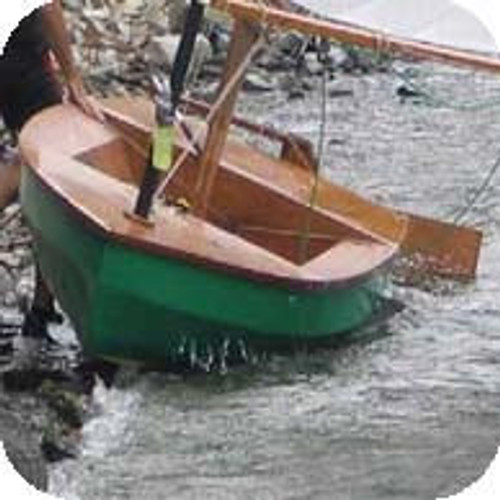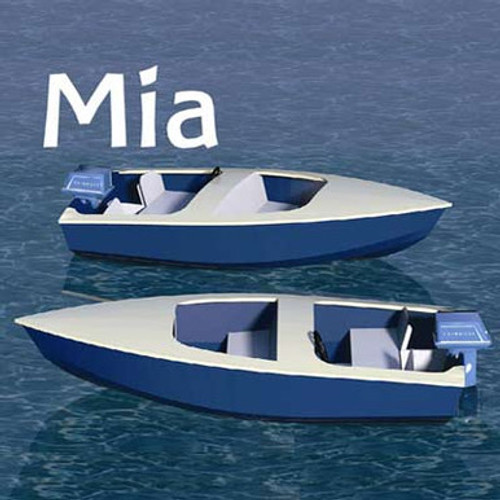Let us now consider these four Ten-footers which have a common (stitch and glue) method of construction and a chine hull. It is perhaps necessary to explain why there are four projects on this theme. Firstly, the opportunity to develop them was given by the fact that in the last few years or so, we have been organizing a design and construction course - usually in spring, having a Ten-footer as object in mind. The course is practical, in the sense that it leads to the construction of one or two boats and is an opportunity to experiment new models which will be tried out during the sailing and racing season. This has lead to a collection of projects that has continuously been enriched with "new entries" and which will probably go on in the future.
Apart from this explanation, we firmly believe in affording our clients the possibility to choose a Ten-footer from a vast choice, in order to meet their special requirements. It is, in fact, difficult to say which is in absolute the best Ten-footer, while it is easier for each helmsman to decide what is more to his favour or liking. It does not necessarily represent the fastest Ten-footer, for two reasons: in the first place, one does not buy a Ten-footer to win a regatta; quite often the scope is to use it for touristic reasons and so one can do without extreme performance in order to privilege other aspects such as comfort, stability and cheapness.
Secondly, even if one's aim is to do well in a regatta, it is not sufficient to have a fast boat, it is also necessary for the helmsman to be able to use his boat properly. To simplify this concept, it is sufficient to examine the evolution of a similar class to the Ten-footer as far as dimensions and rating rules are concerned, but very different as for competitive spirit and level of participants. The Moth class, which is not so widespread in Italy, but particularly common in the United States and in many European states. The class allows complete freedom of choice for the hull, setting limits only for the sail. The result has led to a number of small "monsters", generally made in composite material, extremely narrow (less than 50 cm at waterline) which - on being placed into the water - tend to capsize immediately. With little wind, these boats are very difficult to handle and become a little easier with medium or regular winds, provided that the helmsman has acrobatic qualities. With strong and irregular winds a plunge into the water is assured. However, when they are standing up, these boats, which are practically trimarans without amas (the class does not admit multi-hulls), are extremely fast.
By applying the same criteria to the Ten-footer class, it would be easy to design a winning boat; unfortunately, for the moment there is nobody in the class able to make it win. If there were one, presumably, he would use his talent to excel in other classes with greater prestige or which are more challenging from the technical point of view.
Following this premise, we shall illustrate very briefly what is the most suitable criteria in choosing between the four boats: the fundamental elements of difference between these boats and the most important criteria of choice are the number of chines and beam, both on the water line and on deck. The number of chines leads to a first obvious consequence: more chines means more strakes to be cut and stitched and, consequently, more work. Apart from this, one has to consider that the plywood method of construction and even more so, the "stitch and glue" method, are better suited for boats with flat bottoms. The V type does not represent particular insurmountable difficulties for the constructor, but only a little care and some extra work, above all to obtain a perfectly faired keel line. On the contrary, a larger number of chines offers a few more positive advantages from the structural point of view, as the chine is covered with fibreglass reinforcement. It allows the use of plywood with lower thickness, thus reducing the weight of the hull. From the hydrodynamic point of view a high number of chines generally allows you to create hulls comparable to round ones and so, with less wetted surface: this consideration is correct but quite theoretical because, when you take into consideration a Ten-footer hull, you have to consider that it is quite easy, by moving the weight on board (trimming or heeling the boat), to change the shape of the hull in order to optimize the characteristics, according to the existing sailing conditions. A V shaped hull will sail better in a horizontal position while with a flat bottom, it is more convenient to heel the boat (notice how the children in Optimist heel the boat windward when sailing down wind).
The width of the boat at waterline is - once the length and displacement has been established - the most important factor as far as performance is concerned: a narrow boat will always sail faster than a wider one. Obviously, this will lead to lower stability and less comfort on board. The beam is important because it allows the crew the possibility to lean further out with its weight, thus contrasting the heeling moment caused by the wind. With strong winds it will be more advantageous to have a wider boat. While the beam deck is fixed, waterline beam may vary when the boat starts to heel. For example, it is sufficient to observe the ZEN midsection to understand that it diminishes when the boat heels by around 15 degrees. The boat thus becomes less stable. The opposite occurs in the SCHEGGIA, which is rather unstable when it is flat, but stability increases immediately when the very flared broadsides enter the water. Once these basic hydrostatic concepts have been acquired, it will not be difficult for the reader to have an idea of how these Tenfooters tend to behave.
In summary, we may say that none of these boats are particularly extreme or acrobatic, but all four of them have been designed so as to be competitive. We have adopted the simplest sail plan, the catboat, because it is simpler to manoeuvre and allows the helmsman to concentrate on boat trim and also because it may be mounted with light and strong windsurf masts, that may be easily found on the market. Within this range of common characteristics, the ZEN is undoubtedly the narrowest of the group and therefore the most unstable. It is therefore not the right boat for a beginner but in the hands of a good helmsman, it may be undoubtedly fast; even the JUNIOR is quite narrow and therefore relatively unstable; these characteristics make them less easy to handle with unstable wind conditions, as well as strong winds. The SCHEGGIA is narrow at waterline and therefore does not have great initial stability, but having very flared broadsides, stability increases considerably, as we have already said, when the boat starts to heel. It should behave well even with strong winds and be more tolerant - compared to the previous ones - in case of wrong manoeuvres; obviously, to gain the best performance, it is convenient to maintain it horizontal because, as soon as it heels, the hull becomes much wider and increases resistance. The POLLY is more stable and smoother of the three other boats and is suitable for any helmsman, but may obtain (with the same sail surface), a slightly lower performance. The different characteristics of the hulls that have been just illustrated, also explain the different solutions adopted as far as sail plans are concerned. For the ZEN and JUNIOR, the two most unstable boats, we have adopted the simplest type, the catboat, because it does not require a large sail surface. The POLLY is suitable for two types of sail: sloop type with main sail and jib, suitable for use by two people or for a single crew regatta, or catboat, which is more advisable for those who wish to use the boat more restfully and who do not wish to take part in a competition. The SCHEGGIA, that is above all used for competitions, has a sloop with main sail and jib which allows it to utilize nearly all the sail surface permitted by rating rules, with greater performance, above all when sailing close to the wind. From the construction point of view the boats do not present particular difficulties and thanks to the "stitch and glue" system, they may be built in quite a short time: of simple construction we have the ZEN, followed (according to growing difficulty) by the JUNIOR, POLLY and SCHEGGIA. With the last three, we have adopted the cockpit solution with self emptying double bottom. Apart from the functional advantages, this system allows you to accelerate construction times. The cockpit is practically prefabricated and applied in the hull, which allows "quick and dirty" operations inside the hull, (for example leaving taping of the chines unfinished) thus avoiding long, harmful and tiresome operations.
Zen
length OA 2.98m
deck beam 0.95m
WL beam 0.74m
displacement 36kg
sail araea 7.56m2
PLANS
8 sheets A3
Building
instructions
and material list
hull FLAT BOTTOM
ONE CHINE
sail plan MARCONI CATBOAT
construction method STITCH AND GLUE
skills requested NO EXPERIENCE

__________
Polly
length OA 2.93m
deck beam 1.30m
displacement 43kg
sail area 5.80 m2
PLANS
9 sheets A3
Building
instructions
and material list
hull FLAT BOTTOM
THREE CHINES
sail plan MARCONI CATBOAT
construction method STITCH AND GLUE
skills requested NO EXPERIENCE

__________
Junior
length OA 2.90m
deck beam 1.25m
displacement 38kg
sail area 7.56 m2
PLANS
8 sheetsA3
Building
instructions
and material list
hull V BOTTOM
ONE CHINE
sail plan MARCONI CATBOAT
construction method STITCH AND GLUE
skills requested NO EXPERIENCE

__________
Scheggia
length OA 3.02m
deck beam 1.38m
displacement 36kg
saila area
main sail 5.70 m2
jib 2.00 m2
PLANS
9 sheets A3
Building
instructions
and material list
hull V BOTTOM
TWO CHINES
sail plan MARCONI SLOOP
construction method STITCH AND GLUE
skills requested NO EXPERIENCE






